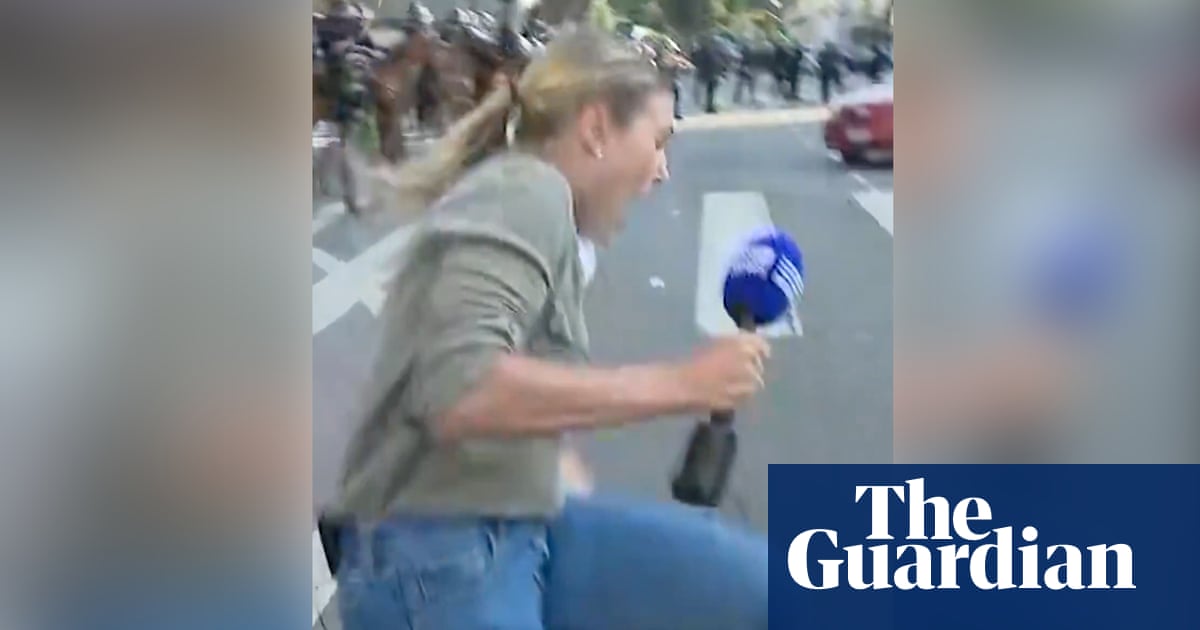Anthony Albanese says footage of the Nine correspondent Lauren Tomasi being shot by a rubber bullet live on air is “horrific” and he has expressed his concern to the US government.
Tomasi was shot while reporting onprotests against immigration raidsin Los Angeles, with the incident caught live on camera. Footage showed an officer taking aim in the direction of Tomasi and her camera operator and then firing.
Albanese said he had spoken to Tomasi and she was “pretty resilient”.
“We have already raised these issues with the US administration,” the prime minister told journalists at the National Press Club. “We don’t find it acceptable that it occurred. And we think that the role of the media is particularly important.”
The prime minister said there was “no ambiguity” that Tomasi was a reporter.
Earlier, Tomasi told the Today show it was “a bit of a shock” to beshot by police, but she only has minor injuries.
“I have a bit of a bloody big old bruise and it’s a little bit sore, but I am all OK,” the US correspondent told Nine on Tuesday.
“It’s a really crappy thing that’s happened. But I really don’t want to be the story … it’s a really chaotic situation that’s unfolding inLos Angeles.”
Sign up for Guardian Australia’s breaking news email
Tomasi is the second journalist to be hit by police during the protests. The British newsphotographer Nick Sternis recovering from emergency surgery for a wound sustained during the standoff between police and anti-Ice protesters on Saturday.
The Los Angeles police chief, Jim McDonnell, said the LAPD was aware and “very concerned” about members of the media getting hit with crowd-control munitions.
Asked at a press conference how the force would minimise injuries to bystanders, including press, he said: “We minimise it through training, through the equipment we use. It is a target-specific munition. That’s not to say that it always hits the intended target, particularly in a dynamic situation.
“I know that situation you’re referring to, with the member of the media. We saw that, we’re very concerned about it and we’re looking into that.”
Tomasi told Today she and the cameraman, Jimmy, went live about 5am LA time after “thousands of protesters” appeared on the street.
“We felt that presence of the LAPD and law enforcement really ramp up and [we] went live … police started pushing their way up the street. They’d begun firing teargas canisters and those rubber bullets, and we moved on to the sidewalk, really tried to stay out of the way,” she said.
“I was really focused on the camera and was finishing that report … and I got hit. Jimmy scooped me up and we made our way out of there as quickly as possible. It was a bit of a shock.”
Sign up toBreaking News Australia
Get the most important news as it breaks
after newsletter promotion
The media union has condemned the shooting. The national media section of the Media, Entertainment and Arts Alliance (MEAA) said Tomasi appeared to be deliberately shot while speaking to the camera.
“Journalists reporting from the frontline of protests and wars fulfil the essential role of bearing witness, and should be accorded the same protections as other frontline workers,” the MEAA chief executive, Erin Madeley, said.
On social media Tomasi thanked people for their messages but indicated she did not want to become the story and she had returned to work. “I’m a bit sore, but I’m OK. Important we keep on telling the stories that need to be told. Here’s our report on what unfolded in Los Angeles.”
The Today show co-host Karl Stefanovic called for a thorough investigation, saying the footage “looks like” Tomasi was deliberately shot.
“She has her back to [the officer]. She has a microphone and is standing in front of a camera. We don’t know what was near her,” he said.
“We don’t know what threat was so imminent it required a cop to discharge his weapon on a reporter, or whether he meant to shoot her. But it sure looks like that to me.
“The incident was maybe one of three things: a moment where an LA officer so thought his life was in danger, he needed to discharge his weapon; an incompetent warning shot; or the act of a coward. Either way, it needs to be properly investigated.”
Stefanovic said correspondents report complex, sometimes dangerous issues and take viewers at home to the frontlines of the story.
“Lauren is a hard-working, tenacious reporter who is always determined to be fair and balanced,” he said. “She’s also the best of us. You will not meet a kinder person.”
